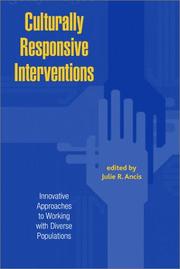| Listing 1 - 10 of 194 | << page >> |
Sort by
|
Dissertation
Year: 2004 Publisher: Liège : Université de Liège. Faculté de médecine (ULg). Département de clinique et pathologie médicales,
Abstract | Keywords | Export | Availability | Bookmark
 Loading...
Loading...Choose an application
- Reference Manager
- EndNote
- RefWorks (Direct export to RefWorks)
Book
Year: 2004 Publisher: Bruxelles: UCL,
Abstract | Keywords | Export | Availability | Bookmark
 Loading...
Loading...Choose an application
- Reference Manager
- EndNote
- RefWorks (Direct export to RefWorks)
Objective: To reduce significantly within six months, the endemic frequency of the nosocomial infections by the promotion of the hygiene measures to the Regional Hospital Center of the Zou/Colline in Benin.
Methods: the supervision methodology N.N.I.C. is applied to the study: the prevalence of the nosocomial infections of the surgical site before and after the promotion campaign of the hygiene measures, cumulative incidence of urinary nosocomial infections spread on three month. The prevention model based on hands hygiene experienced by CLIN South West in France is used to evaluate by quick audit the rate of observance of hands hygiene and its improvement by a campaign education of the hospital staff. Strategic analysis of organisation is used to appreciate hospital environment and identify the representations of nosocomial infections among the hospital staff. Statistic analysis of the data was done by the Pearson chi-square homogeneity test or the exact test of Fisher and the test chi-square tendency.
Results:
Stage 1
Before the promotion campaign of the hygiene measures on 175 patients who have been operated and followed, 72 patients developed an infection of the surgical site, or a prevalence of 41%. Pseudomonas aeruginosa is the organism most frequently isolated in wounds (20%) which is also often present in the hospital environment. The rate of observance of hands hygiene during the same period is 23%. The quality of the sterilization and disinfection if poor.
Stage 2
On a total of 484 hospitalized patients followed in the medicine service without urinary infection at admission, 150 will contract a urinary infection during their hospitalisation, with a cumulative incidence of 31%. The cumulative incidence in June is 37%, progressively diminished to reach 22% at the end of the program in late August. Strategic analysis of organisation revealed two different entities through their functions within the hospital, and the report to hygiene observance. The participation rate if the personnel is of 81%, 277 out of 340.
Stage 3
After the promotion campaign of the hygiene measures, on 200 patients operated and followed in our patients developed an infection at the surfical site, or a prevalence of 13%. Enterobacteriaceae are the organisms which are most frequently isolated in wounds (27%). The rate of observance of hands hygiene during the same period was 53%.
Conclusions:
- It is possible to prevent nosocomial infections by the promotion of hygiene measures in our context while applying the methodology currently used in developed countries.
- The endemic prevalence of nosocomial infections is high and the rate of hands hygiene observance is low.
- The campaign allowed an improvement of the hygiene measures resulting in the reduction of 28% (p<10-5) of the nosocomial infections initial prevalence and an increased of 30% (p<10-5) rate of hands hygiene observance
- Representations carried out by the hospital staff on the nosocomial infections orientate their actions on observances and determine conditions of the inter-personnel relationship Objectifs : Réduire de manière significative en six mois, la fréquence endémique des infections nosocomiales par la promotion des mesures d’hygiène au Centre Hospitalier Départemental Zou/Collines au Bénin.
Méthodes : La méthodologie de surveillance N.N.I.S. est appliquée pour étudier : la prévalence des infections nosocomiales du site opératoire avant et après la campagne de promotion des mesures d’hygiène, l’incidence cumulée des infections urinaires nosocomiales sur trois mois.
Le modèle de prévention basé sur l’hygiène des mains expérimenté par le CLIN Sud Ouest en France est utilisé par évaluer par quick audit le taux d’observance de l’hygiène des mains et son amélioration par une campagne d’éducation du personnel hospitalier.
L’analyse stratégique d’organisation a permis d’apprécier l’environnement hospitalier et d’identifier les représentations des infections nosocomiales chez le personnel hospitalier.
L’analyse statistique des données a été faite par le test khi-carré d’homogénéité de Pearson ou le test de Fisher et le test khi-carré de tendance.
Résultats :
Phase 1
Avant la campagne de promotion des mesures d’hygiène, sur 175 patients opérés et surveillés 72 patients ont développé une infection du site opératoire soit une prévalence de 41%. Pseudomonas aeruginosa est le genre le plus fréquemment isolé des plaies (20%) et qui est aussi très présent dans l’environnement hospitalier. Le taux d’observance de l’hygiène des mains durant la période est de 23%. La qualité de la stérilisation et la désinfection est médiocre.
Phase 2
Au total sur 484 patients hospitalisés dans le service de médecine sans infection urinaire à l’admission et surveillés, 150 vont contracter une infection urinaire pendant leur hospitalisation, soit une incidence cumulée de 31%. L’incidence cumulée au mois de juin de 37%, à progressivement diminué pour atteindre 22% à la fin du programme en fin août. L’analyse stratégique d’organisation a révélé deux entités différentes de part leur fonctionnement au sein de l’hôpital, et les différentes représentations des infections nosocomiales chez le personnel hospitalier qui sont en harmonie avec leur rapport à l’observance de l’hygiène. Le taux de participation du personnel est de 81%, 277 sur 340.
Phase 3
Après la campagne de promotion des mesures d’hygiène, sur 200 patients opérés et surveillés 26 patients ont développé une infection du site opératoire soit une prévalence de 13%. Les entérobactéries sont les germes les plus fréquemment isolés des palais 27%. Le taux d’observance de l’hygiène des mains durant la même période est de 53%.
Conclusions
- Il est possible de prévenir les infections nosocomiales par la promotion des mesures d’hygiène dans notre contexte en appliquant la méthodologie utilisée actuellement dans les pays développés.
- La prévalence endémique des infections nosocomiales est élevée et le taux d’observance de l’hygiène des mains associé est bas.
- La campagne a permis une amélioration des mesures d’hygiène concrétisée par la réduction absolue de 28% (p<10-5) de la prévalence initiale des infections nosocomiales et une augmentation de 30% (p<10-5) du taux d’observance de l’hygiène des mains.
- Les représentations véhiculées par le personnel soignant sur les infections nosocomiales orientent leurs actions par rapport à l’observance et conditionnent les relations interpersonnelles
Cross Infection --- Benin
Book
Year: 2004
Abstract | Keywords | Export | Availability | Bookmark
 Loading...
Loading...Choose an application
- Reference Manager
- EndNote
- RefWorks (Direct export to RefWorks)
Book
Year: 2004 Publisher: New York : Brunner-Routledge,
Abstract | Keywords | Export | Availability | Bookmark
 Loading...
Loading...Choose an application
- Reference Manager
- EndNote
- RefWorks (Direct export to RefWorks)
Book
Year: 2004 Publisher: Gaithersburg, MD : U.S. Dept. of Commerce, National Institute of Standards and Technology,
Abstract | Keywords | Export | Availability | Bookmark
 Loading...
Loading...Choose an application
- Reference Manager
- EndNote
- RefWorks (Direct export to RefWorks)

ISBN: 0802824951 Year: 2004 Publisher: Grand Rapids Eerdmans
Abstract | Keywords | Export | Availability | Bookmark
 Loading...
Loading...Choose an application
- Reference Manager
- EndNote
- RefWorks (Direct export to RefWorks)

ISBN: 030647770X Year: 2004 Publisher: Dordrecht Kluwer Academic
Abstract | Keywords | Export | Availability | Bookmark
 Loading...
Loading...Choose an application
- Reference Manager
- EndNote
- RefWorks (Direct export to RefWorks)

ISBN: 9780415933339 0415933331 0415933323 0203486161 9780203486160 9781135953980 1135953988 9786610048946 6610048940 1280048948 9781280048944 9781135953935 9781135953973 9780415933322 113595397X Year: 2004 Publisher: New York : Brunner-Routledge,
Abstract | Keywords | Export | Availability | Bookmark
 Loading...
Loading...Choose an application
- Reference Manager
- EndNote
- RefWorks (Direct export to RefWorks)
This book fills the widening gap in multicultural literature by providing specific culture-centered interventions. The first section of the text highlights culturally based interventions. The second section focuses on the treatment of Culture-Bound Syndromes (CBS). Culture-Bound Syndromes are defined as recurrent, locality specific behavior patterns that are observed only in certain cultural environments. The third section, clinical and training implications, includes a chapter describing how training will need to be reconceptualized in order to promote counselors who are effective with a wide
Cross-cultural counseling --- Counseling transculturel --- Cross-cultural counseling.
Book
ISBN: 8473925335 Year: 2004 Volume: 21 Publisher: Madrid Fundación Universitaria Española
Abstract | Keywords | Export | Availability | Bookmark
 Loading...
Loading...Choose an application
- Reference Manager
- EndNote
- RefWorks (Direct export to RefWorks)
Book
ISBN: 9789707014817 Year: 2004 Publisher: México, D.F. Miguel Ángel Porrúa
Abstract | Keywords | Export | Availability | Bookmark
 Loading...
Loading...Choose an application
- Reference Manager
- EndNote
- RefWorks (Direct export to RefWorks)
| Listing 1 - 10 of 194 | << page >> |
Sort by
|

 Search
Search Feedback
Feedback About UniCat
About UniCat  Help
Help News
News